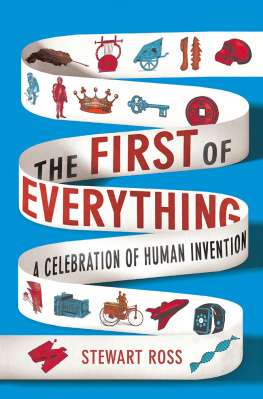Stewart Ross - Who Invented Underpants?
Here you can read online Stewart Ross - Who Invented Underpants? full text of the book (entire story) in english for free. Download pdf and epub, get meaning, cover and reviews about this ebook. year: 2020, publisher: Ulysses Press, genre: Non-fiction. Description of the work, (preface) as well as reviews are available. Best literature library LitArk.com created for fans of good reading and offers a wide selection of genres:
Romance novel
Science fiction
Adventure
Detective
Science
History
Home and family
Prose
Art
Politics
Computer
Non-fiction
Religion
Business
Children
Humor
Choose a favorite category and find really read worthwhile books. Enjoy immersion in the world of imagination, feel the emotions of the characters or learn something new for yourself, make an fascinating discovery.

- Book:Who Invented Underpants?
- Author:
- Publisher:Ulysses Press
- Genre:
- Year:2020
- Rating:3 / 5
- Favourites:Add to favourites
- Your mark:
- 60
- 1
- 2
- 3
- 4
- 5
Who Invented Underpants?: summary, description and annotation
We offer to read an annotation, description, summary or preface (depends on what the author of the book "Who Invented Underpants?" wrote himself). If you haven't found the necessary information about the book — write in the comments, we will try to find it.
Who Invented Underpants? — read online for free the complete book (whole text) full work
Below is the text of the book, divided by pages. System saving the place of the last page read, allows you to conveniently read the book "Who Invented Underpants?" online for free, without having to search again every time where you left off. Put a bookmark, and you can go to the page where you finished reading at any time.
Font size:
Interval:
Bookmark:


Text copyright 2020 Stewart Ross. Design copyright 2020 Ulysses Press and its licensors. All rights reserved. Any unauthorized duplication in whole or in part or dissemination of this edition by any means (including but not limited to photocopying, electronic devices, digital versions, and the internet) will be prosecuted to the fullest extent of the law.
Published in the United States by:
Ulysses Press
P.O. Box 3440
Berkeley, CA 94703
www.ulyssespress.com
First published in Great Britain in 2019 as The First of Everything by Michael OMara Books Limited.
ISBN: 978-1-64604-097-1
Library of Congress Control Number: 2020936417
Acquisitions editor: Casie Vogel
Managing editor: Claire Chun
US editors: Renee Rutledge, Barbara Schultz
Cover and interior design: what!design @ whatweb.com
Cover photos: from shutterstock.com; background MM_photos; key AVA Bitter; toothbrush Alexander_P; burger Sketch Master; bicycle, toilet Hein Nouwens; fire, cigarettes Bodor Tivadar; underwear nikiteev_konstantin
Interior photos: see
To Lucy, without whose unstinting and generous efforts as proofreader, fact checker, and warm-hearted supporter this book could not possibly have been completed.
To research the first instances of literally everything (even the first book of firsts!) would be an infinite task. Inevitably, therefore, this book is selective. The criteria for inclusion are twofold. One, the very first of a typefor example, I have written about the first washing machines, including the first electric ones, but not about the vast subspecies of electric washing machines, such as fully automatic, twin tub, etc. This should make plain the second criterion: I have included only such firsts as would, in my judgment, interest the general readerwhom I hope is not a washing machine aficionado.
What makes this book different from other books of firsts? As well as being extremely broad-ranging and comprehensive, it is, as far as I am aware, the only one to put historical achievements in their rightful place. In other words, instead of concentrating on modern and largely Western gadgetry, I have attempted to give due weight to the inventiveness of our distant ancestors in the ancient civilizations of Egypt, China, and the Middle East. In doing so, I have been surprised by how many supposed inventions of the industrial world (e.g., air conditioning) are in fact reinventions of, or improvements on, creations and behaviors of many thousands of years ago. By attempting to redress the imbalance of esteeming modern technology over traditional ingenuity, we find the USA and the ancient world share the gold medal position on the podium of firsts, with the UK and France one step down.
I suspect few readers will be steadfast enough to read through the entire book, cover to cover, and most will dip into it for entertainment or use it as a work of reference for trivia quizzes or to settle family arguments. To make these tasks easier, the contents have been arranged under three types of headings: the seven sections (In the Beginning; At Home; Health and Medicine; Getting Around; Science and Engineering; Peace and War; and Culture and Sports) are each divided into topics, which in turn are subdivided into subjects.
Finally, readers may wonder about this books accuracy. Sources often differ widely, and precise dates are frequently controversial: is the date for the first of a certain type of machine, for instance, when it was dreamed up, when it was patented, when the prototype was built, or when it went into production? With this in mind, I have done my best to be clear and accurate; even so, in places I am sure I have fallen short. I apologize unreservedly for any confusion and frustration (even anger!) these inadvertent slips may cause.
STEWART ROSS
NOTE: COUNTRY OF ORIGIN
Where relevant or known, the place where something was first used, discovered, or invented is identified by the name of the present-day country occupying that region. This was not necessarily the name current at the time, nor did ancient boundaries coincide with modern ones. Thus, firsts from Persia are generally labeled as Iran, Anatolia as Turkey, Mesopotamia as Iraq, etc.
The first first, more or less by definition, was the Big Bang of some 13.8 billion years ago that created time, the universe and everything. Everything? Even whatever it was that went bang? Lets not go there
The first life on Eartha much easier conceptis thought to have emerged 4.28 billion years ago, when our young planet was celebrating its 26 millionth birthday. Scientists refer to this first life thing (the simplest of microorganisms) as LUCAthe Last Universal Common Ancestor. Apparently, were all descended from LUCA.
LUCAs descendants took a very long time to evolve into the genusHomo, which appeared only about 2.1 million years ago. Its identifying features were an ape-like physiognomy, a bulging brain, and an ability to use primitive tools (another first)hence its name, Homo habilis or handy man.
About 200,000 years later, Homo erectus (upright man) had developed. This creatures even larger brain may have enabled it to speak (if so, we have the first language). The species had possibly learned to handle fire (one more first, see ) and certainly made tools of greater sophistication; it was also spreading out from Africa to populate the globe.
Were not quite sure what happened next. However, from among the variety of Homo types, by c. 50,000 BC Homo sapiens (intelligent man) was hunting and gathering in the inclement conditions of the last glacial period. These were the first modern human beings, forebears of the extraordinarily inquisitive and inventive men and women responsible for the astonishing catalog of firsts that follows.

The skulls of Homo sapiens (left) and of his unsuccessful relative, Homo neanderthalensis
Human development is evolutionary and cumulative; or, in the words of Sir Isaac Newton (repeating a well-known idea of classical origin), new ideas and objects came from people standing on the shoulders of giants. We have already met some of those giants, the primitive, anonymous people who made three vital early breakthroughs: fire, tools, and speech.
The baton now passes to Homo sapiens for perhaps the most significant of all firsts: agriculture. The change from hunting animals and gathering food to considered husbandry took place independently in some dozen different parts of the world, beginning with the domestication of pigs in Mesopotamia (Iraq) in about 13,000 BC. Within a few thousand yearsagain in the Middle Eastfields of wheat, barley, and other crops were flourishing beside pigsties, all tended by the first farmers.
Font size:
Interval:
Bookmark:
Similar books «Who Invented Underpants?»
Look at similar books to Who Invented Underpants?. We have selected literature similar in name and meaning in the hope of providing readers with more options to find new, interesting, not yet read works.
Discussion, reviews of the book Who Invented Underpants? and just readers' own opinions. Leave your comments, write what you think about the work, its meaning or the main characters. Specify what exactly you liked and what you didn't like, and why you think so.






